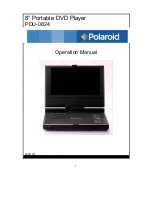
5
OPM-128/E
INTRODUCTION
INTENDED USES
This engine generator set has been designed primarily for
portable heavy duty commercial use. Both 120 volt and 240
volt receptacles are provided in the control panel to plug
in your loads (lights, portable tools, and small appliances).
These units are dual wound generators, therefore the
120 volt loads must be equally split with 1/2 of the rated
capacity available on each of the two 120 volt circuits.
This portable unit requires large quantities of fresh air for
cooling the engine and generator. For safety, long life and
adequate performance, these units should never be run in
small compartments without positive fresh air flow.
RESTRICTED USES
DO NOT
remove from the cradle assembly. Removal of the
generator from the cradle assembly may cause excessive
vibration and damage to the engine-generator set.
DO NOT
operate and/or store the unit outside during
inclement weather without adequate protection from the
elements. Failure to do so will damage the unit.
DO NOT
install and operate this generator in a small
compartment., i.e. generator compartments of vehicles,
motor homes or travel trailers. These compartments
will not allow enough free flow of fresh air to reach the
engine generator set for cooling and will cause the unit to
overheat, damaging both the engine and generator. Small
compartments will also develop hot spots where there is
very little air flow and may cause a fire.
PLEASE NOTE
There are 3rd party companies making
enclosures for generators that have been properly
engineered. The use of these 3rd party enclosures is
acceptable as long as they have been certified and meet
current code.
DO NOT
attempt to operate at 50 cycles. These units are
designed and governed to operate at 60 cycles only.
UNIT CAPABILITIES
GENERATOR CONNECTIONS
DP5000/T: 120 Volt and 240 Volt receptacles are provided
for connection to various loads. The diagram below
represents this 4,500 watt (rated output) generator. A & B
represent the 120 volt output legs of this generator. Up to
2,250 watts at 120 volts (37.5 Amps) can be drawn from
the receptacles attached to either A or B output legs. This
generator is capable of producing 37.5 Amps of 240 volt
current at C. Check the appliance or tool nameplates for the
current and voltage to insure compatibility. Remember that
power taken from C reduces the power available equally at
both A and B and vice versa.
STARTING ELECTRIC MOTORS
Electric motors require much more current (amps) to start
them than to run them. Some motors, particularly low cost
split-phase motors, are very hard to start and require 5 to 7
times as much starting current as running current. Capacitor
motors are easier to start and usually require 2 to 4 times
as much starting current as running current. Repulsion
Induction motors are the easiest to start and require only 1
1/2 to 2 1/2 times as much starting as running current.
Most fractional horsepower motors take about the same
amount of current to run them whether they are Repulsion
Induction (RI), Capacitor (Cap), or Split-Phase (SP) type.
If the electric motor is connected to a hard starting load,
such as an air compressor, it will require more starting
current. If it is connected to a light load, or no load, such as
a power saw, it will require less starting current. The exact
requirement will also vary with the brand or design of the
motor.
Self-exciting generators respond to severe overloading
differently than utility power. When overloaded, the engine
is not able to supply enough power to bring the electric
motor up to operating speed. The generator responds with
high initial starting current, but the engine speed drops
sharply. The overload may stall the engine. If allowed to
operate at very low speeds, the electric motor starting
winding will burn out in a short time. The generator
winding might also be damaged.
CAUTION: EQUIPMENT DAMAGE
Running the generator set under these conditions may
result in damage to the generator stator as well as the
motor winding.
The heavy surge of current required for starting motors
is required for only an instant. The generator will not be
damaged if it can bring the motor up to speed in a few
seconds of time. If difficulty is experienced in starting
motors, turn all other electrical loads off and if possible
reduce the load on the electric motor.


































